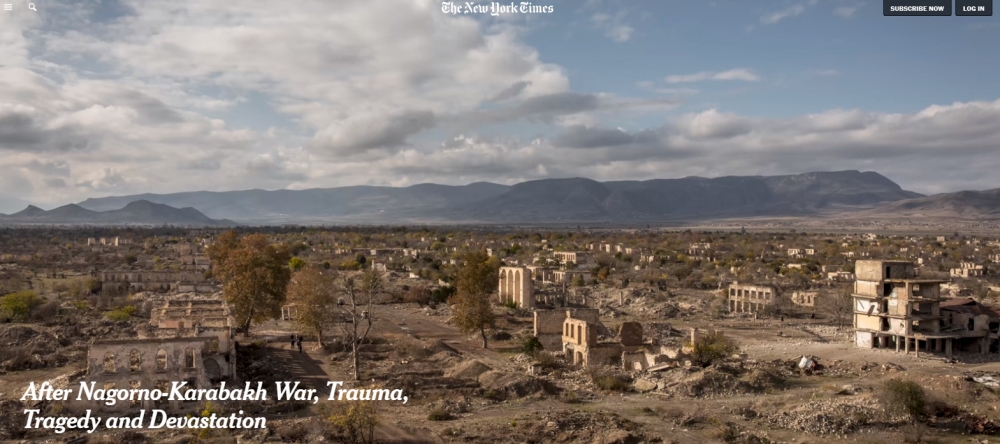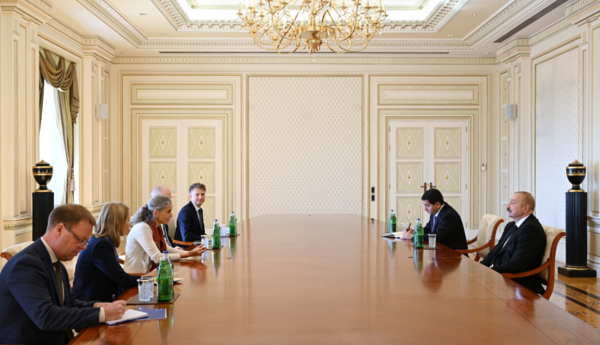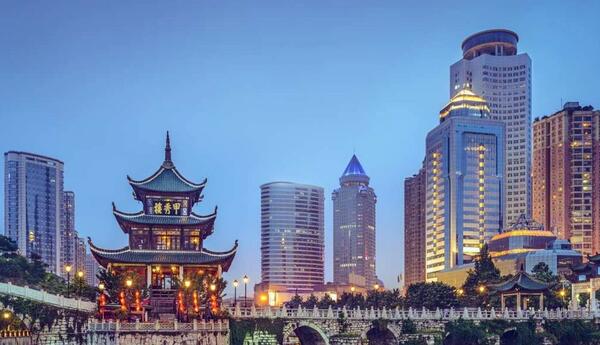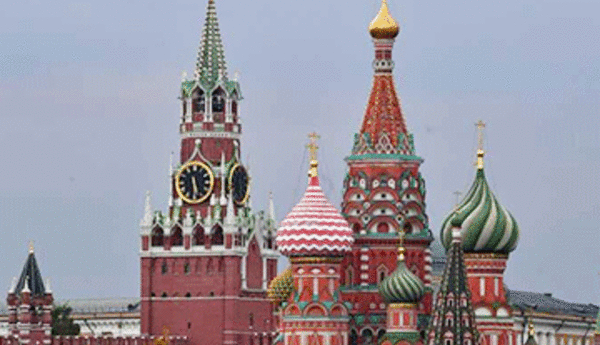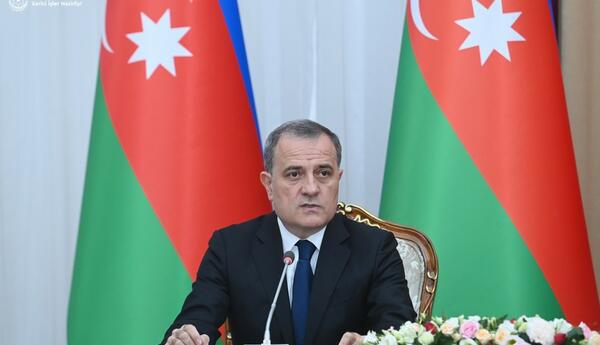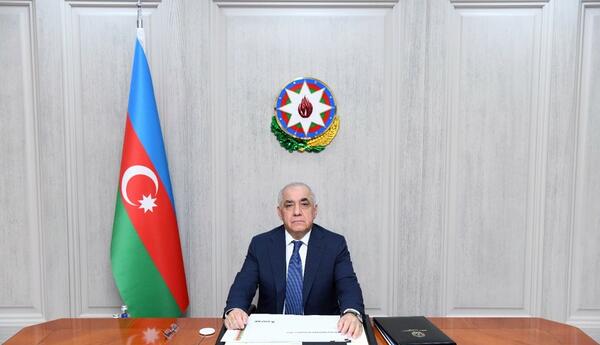For Armenians uprooted from their homes, and for Azerbaijanis returning to uninhabitable towns, “It’s going to be very hard to forgive.”
By Carlotta Gall and Anton Troianovski
Photographs by Mauricio Lima and Ivor Prickett
Fizuli, Azerbaijan — Crossing into territory that Azerbaijan recently recaptured from Armenia is a journey into a devastated wasteland reminiscent of a World War I battlefield. The road passes miles of abandoned trenches and bunkers, and village after village of ruins, the white stones of homesteads scattered, every movable item — roofs, doors, window frames — picked clean.
The absence of life is eerie.
Wrecked Armenian tanks and armor lay beside the road and in hilltop positions, testament to the devastating power of Azerbaijani drones. Abandoned uniforms and equipment signal a panicked retreat by Armenian soldiers as Azerbaijani forces seized control of the district in early November.
Decades after the surrounding territory was seized by Armenia, the town of Fizuli, once a prosperous agricultural settlement of some 30,000 people, has become a forest, its ruined public buildings smothered by trees and undergrowth. The fate of the larger town of Aghdam, further north, is even more stark, its buildings split open to the skies on a desiccated plain, its main bridge destroyed.

Bütün xəbərlər Facebook səhifəmizdə
Other news

Latest news
Pashinyan criticizes Biden administration for policy in South Caucasus
Politics 28 Avqust 17:43Karabakh urban planning office relocated from Barda to Khankendi
Politics 28 Avqust 16:25Ministry: Türkiye to provide necessary support to protect Syria's territorial integrity
World 28 Avqust 15:23Ilham Aliyev receives EU Special Representative for South Caucasus
Politics 28 Avqust 14:3726 foreign leaders to attend China's V-Day commemorations on September 3
Politics 28 Avqust 13:16Azerbaijan's ambassador presents credentials to Venezuelan president
World 28 Avqust 12:33Israeli ambassador congratulates Qarabag on UCL league phaze qualification
Sport 28 Avqust 11:54Sybiha: Building of EU mission in Ukraine damaged by Russian attacks
Event 28 Avqust 10:2333 years pass since Balligaya massacre committed by Armenians
Event 28 Avqust 09:23Kremlin declines to comment on possible meeting between Presidents of Azerbaijan and Russia
Politics 27 Avqust 16:24Deputy MP: New route to be created connecting Gulf countries to Black Sea
Economy 27 Avqust 15:46Ilham Aliyev: Azerbaijan totally ignores false narratives articulated by Iranian so-called advisors
Politics 27 Avqust 15:00President of Azerbaijan says OTS will become one of important global players
World 27 Avqust 14:31President: Dissolving Minsk Group was one of Azerbaijan’s early demands
World 27 Avqust 13:36President: We can provide gas supplies to other countries through Arabian Gas Pipeline
Economy 27 Avqust 12:45Azerbaijani president: Trump really deserves Nobel Peace Prize
World 27 Avqust 12:17Ilham Aliyev reveals condition for signing peace agreement with Armenia
Politics 27 Avqust 11:28President of Azerbaijan Ilham Aliyev gives interview to Al Arabiya TV channel
Politics 27 Avqust 10:30Another group of former IDPs leaves for Khidirli village in Azerbaijan's Aghdam district
World 27 Avqust 09:07OSCE countries expected to decide to disband Minsk Group on September 1
Politics 26 Avqust 17:17Jeyhun Bayramov: Azerbaijan has never accepted interim solutions contrary to national interests
Politics 26 Avqust 16:46Aviation forces deployed to extinguish fires in Khojavand and Aghdara
Event 26 Avqust 15:17Formula 1: Tickets for 9 of 12 stands at Azerbaijan Grand Prix already sold out
Sport 26 Avqust 14:38US to spend $100M to combat migrants
World 26 Avqust 13:24Japan protests China's installation of structure in East China Sea
World 26 Avqust 12:41Trump says he doesn’t know whether Putin-Zelenskyy meeting will be held
World 26 Avqust 11:39Erdogan: Economic cooperation between Türkiye, Azerbaijan, Armenia to reach new stage
Economy 26 Avqust 10:28Today marks Mehriban Aliyeva's birthday
Politics 26 Avqust 09:15Gulf Research Center: Peace in South Caucasus opening new horizons for Gulf states
Culture 25 Avqust 17:45Victim of Armenian attacks: 'We were subjected to fire from Gorus when we passed through Lachin'
Politics 25 Avqust 16:28About 88% of residents provided with jobs in liberated territories of Azerbaijan
Economy 25 Avqust 15:37New loan campaign from Kapital Bank: 6,000 AZN for just 190 AZN per month
Economy 25 Avqust 15:13Trial in criminal case of those accused of military and other crimes continues in Baku
Social 25 Avqust 14:21Azerbaijan launches Digital Public Financing information system
Technology 25 Avqust 13:45Romanian senator climbs Mount Heydar Aliyev
Interesting 25 Avqust 12:24Azerbaijan eases visa rules for Formula 1 visitors
Sport 25 Avqust 11:37UN World Food Programme head slams situation in Gaza as ‘catastrophic’
World 25 Avqust 10:50Kyiv needs guarantees ‘roughly corresponding’ to NATO membership — German FM
World 25 Avqust 10:23Syria, Israel make progress towards security agreement — Syrian president
World 25 Avqust 09:45President of Ukraine thanks Azerbaijan for support provided to his country
Politics 25 Avqust 09:16France summons Italian envoy in wake of minister’s call to send Macron fight in Ukraine
Politics 23 Avqust 14:43North Korea says South Korea fired warning shots in border region
World 23 Avqust 13:27Trump announces U.S. acquisition of 10% stake in Intel
Technology 23 Avqust 12:30Russia, US discuss options for working together in Alaska — Putin
World 23 Avqust 11:40Pentagon chief fires head of Defense Intelligence Agency
World 23 Avqust 10:35Share of settlements in rubles between Russia, Azerbaijan reached 79.8% in May
Economy 23 Avqust 09:23Prosecutor General: Zangazur corridor to contribute to regional economic, political integration
Economy 22 Avqust 15:23High-level meeting between Turkmenistan, Azerbaijan, and Uzbekistan begins in Turkmenbashi
Politics 22 Avqust 14:44Gazprom temporarily suspends Armenia gas supply citing maintenance
Economy 22 Avqust 13:28Russian president congratulates Mehriban Aliyeva on her birthday
Politics 22 Avqust 12:30Ilham Aliyev holds expanded meeting with Chairman of Halk Maslakhaty of Turkmenistan
World 22 Avqust 11:45Ilham Aliyev's one-on-one meeting with Gurbanguly Berdimuhamedov concludes
World 22 Avqust 10:32President Ilham Aliyev arrives in Turkmenistan on working visit
Politics 22 Avqust 10:01Former IDPs go back to their native lands in Khidirli village of Azerbaijan’s Aghdam
Social 22 Avqust 09:28Ministry of Digital Development reports massive DDoS attack on Delta Telekom
Economy 21 Avqust 17:12President and First Lady meet with residents of Vangli and Kolatag villages in Aghdara
Politics 21 Avqust 16:38Preoperative Assessment of TAVI Patients
Health 21 Avqust 15:33Cable car in Lachin to be completed next year
Social 21 Avqust 14:23Ilham Aliyev: The infamous Minsk Group is living its final days
World 21 Avqust 13:35President Ilham Aliyev meets with Kalbajar residents and presents apartment keys
Social 21 Avqust 12:21President Ilham Aliyev lays foundation of Kalbajar city park
World 21 Avqust 11:19Azerbaijani Ambassador presents credentials to President of Dominican Republic
World 21 Avqust 10:27Foundation of 4th residential complex laid in Kalbajar
Social 21 Avqust 10:24Ilham Aliyev and Mehriban Aliyeva review works on Toghanali–Kalbajar–Istisu highway
Economy 21 Avqust 09:27Jeyhun Bayramov discusses Azerbaijan-EU relations with Spanish Foreign Minister
Politics 20 Avqust 17:42President and First Lady review construction progress at Ganja City Stadium
Sport 20 Avqust 17:00Foundation laid for basalt products manufacturing facility in Ganja
Economy 20 Avqust 16:23President and First Lady review construction works at Ganja Memorial Complex
Social 20 Avqust 15:39President Ilham Aliyev and First Lady Mehriban Aliyeva visit Ganja
Social 20 Avqust 15:07Sophie Lagoutte: Looking forward to continuing discussions to strengthen ties with Azerbaijan
Politics 20 Avqust 14:23Aircraft en route to Dushanbe makes emergency landing in Baku
Event 20 Avqust 13:46Number of households with high-speed Internet in Azerbaijan reaches 3 million
Economy 20 Avqust 13:00Earn with friends at Birbank Biznes
Economy 20 Avqust 12:59“What is Myocarditis?”
Health 20 Avqust 12:47Leyla Abdullayeva expresses hope for development of Baku–Paris relations under new ambassador
Politics 20 Avqust 12:17Planet no longer heading to World War Three — Trump
Interesting 20 Avqust 11:38Trump says Iran would have developed nuclear weapons in four weeks
World 20 Avqust 10:27US selling arms to Europe that are sold on to Ukraine with 10% markup — Bessent
World 20 Avqust 09:47Trump says Putin-Zelensky meeting being set up
World 20 Avqust 09:16Lavrov: Trump took deeper approach to settlement in Ukraine after Alaska summit
World 19 Avqust 17:42Pezeshkian, Pashinyan comment on Iran-Armenia bilateral talks in Yerevan
World 19 Avqust 16:37Nepal congratulates Azerbaijan on progress in normalizing relations with Armenia
Politics 19 Avqust 15:26President Ilham Aliyev receives President of Global Affairs at Goldman Sachs Group Inc
Economy 19 Avqust 14:13Bir Ecosystem showcased at the international “Ai4 2025” conference
Economy 19 Avqust 14:05Hungary may host meeting between Putin and Zelenskyy
World 19 Avqust 13:38Nar honored with prestigious “Stevie” Award
Technology 19 Avqust 12:24UEFA Champions League: Qarabag to play first play-off match tonight
Sport 19 Avqust 12:18France agrees to return earlier detained Azerbaijani children to Germany
Social 19 Avqust 11:36Kyiv rejected any deal involving territorial concessions to Russia – Financial Times
World 19 Avqust 10:24Putin told Trump he is ready to meet Zelenskyy: source familiar with talks
World 19 Avqust 09:47Trump says he begins preparations for Putin-Zelenskyy meeting
Politics 19 Avqust 09:08Ilham Aliyev receives credentials of newly appointed Israeli ambassador
Politics 18 Avqust 17:12Private news
Digər xəbərlərPresident Ilham Aliyev congratulates Donald Trump
Politics 4 İyul 11:37Accuracy of landmine maps provided by Armenia was 25%
Politics 4 Aprel 09:32Presidents of Azerbaijan and Iran exchange congratulations on Ramadan holiday
Politics 31 Mart 15:39Central Asian Countries' War on Gas
Politics 14 May 2024 18:03Seventh International Mugham Festival 'Kharibulbul' held in Shusha
Culture 13 May 2024 18:07Large-scale protests supporting Palestine emerge in US from late April to early May
Politics 3 May 2024 18:07
Redactor's choice
Popular
Exchange rates
-
 USD
1,7000
USD
1,7000
 0,00%
0,00%
-
 EUR
1,9786
EUR
1,9786
 +0,21%
+0,21%
-
 GBP
2,2956
GBP
2,2956
 +0,41%
+0,41%
-
 RUB
2,1157
RUB
2,1157
 +0,19%
+0,19%



